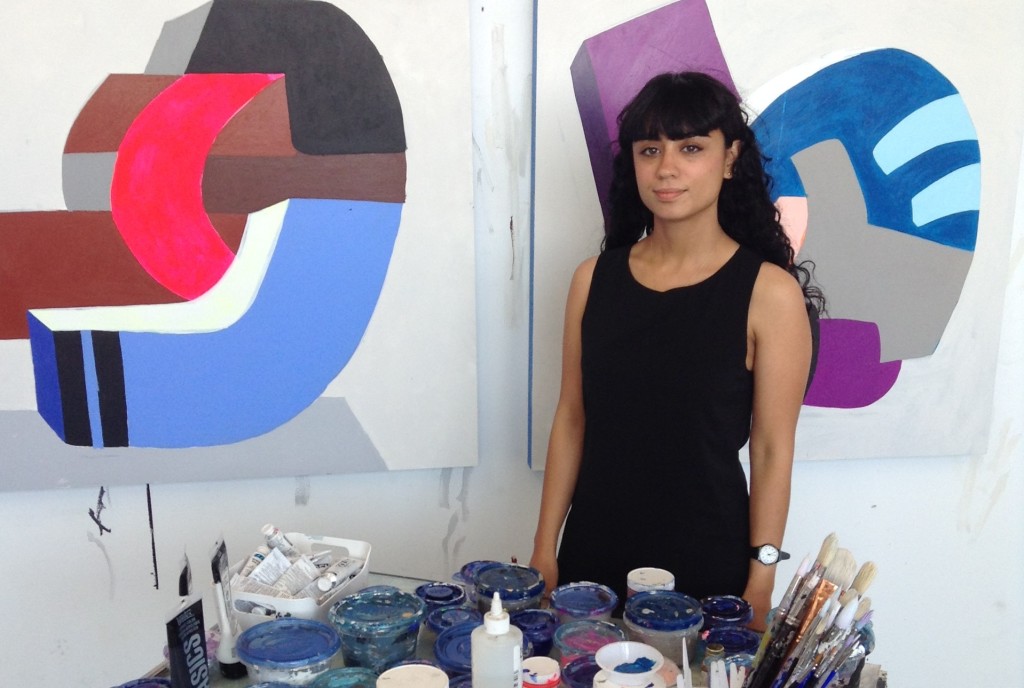My first encounter with artist Hayal Pozanti was the lucky happenstance of a predetermined seating arrangement: she was placed across the table from me at a dinner celebrating Jessica Silverman Gallery, which represents Pozanti on the West Coast. We spent the evening in deep discussion on the finer points of photographic theory and discovered a shared interest in the writings of Friedrich Kittler. Agreeing to stay in touch, I found myself in New York for Frieze Art Fair and decided to pay a visit to Pozanti’s studio in Queens. She was born in Istanbul in 1983, and moved to New York in 2009. In a small, partitioned space with views looking over the East River toward Midtown Manhattan, we talked about her current body of work, which will be exhibited later this year at the Prospect New Orleans biennial and at the Parisian iteration of the Foire Internationale d’Art Contemporain.
With my recent paintings, I’ve been thinking a lot about Ken Price, Philip Guston, and Allan McCollum. And, of course, I always come back to Giorgio Morandi—I think about him regularly. I find that a common ground for all of these artists was the ability to create, through figurative abstraction, a world parallel to the one we live in. As a Turkish immigrant who has moved from place to place, who speaks several languages, I’m intrigued by the possibility of creating a universal language to unite my cross-cultural experiences. When I think back to my childhood in Istanbul—even to my time as a young professional there—I was always concerned with the question of acceptance and with the idea of unifying people.
My early paintings were very figural—I was looking at Turkish miniatures and thinking about the Abrahamic religions I was in contact with daily. While getting my M.F.A at Yale and studying with Peter Halley, my practice was based on images that I would collect from the Internet. I was really engrossed in that culture of image collecting, collaging. But I realized that I couldn’t propose something new by appropriating things. I wanted to step away from the computer, because I was spending so much time in front of the screen, sitting there staring at something with dozens of tabs open.  I decided to invent my own language, through abstraction. I was deeply intrigued by hieroglyphic and pictographic-based civilizations, and often I would take the train down from New Haven to visit the Met’s collection of Mesoamerican artifacts. I also have a background in graphic design—prior to making art full time, I worked in a corporate environment developing visual branding—so I have a familiarity with making signs and symbols.
I decided to invent my own language, through abstraction. I was deeply intrigued by hieroglyphic and pictographic-based civilizations, and often I would take the train down from New Haven to visit the Met’s collection of Mesoamerican artifacts. I also have a background in graphic design—prior to making art full time, I worked in a corporate environment developing visual branding—so I have a familiarity with making signs and symbols.
My initial approach to shape-making was variations on “a circle in a square.” After generating hundreds of sketches, I noticed similarities in form and order. This led me to narrow it down to thirty-one signs—an alphabet, if you will. After that, I began combining those initial signs to produce additional ones, much like creating words and sentences from letters.
I free-sketch most of the time. Then I put the sketch-painting in the computer and keep painting on the computer. I have a track pad, so I’m still using my hands.  When I’ve adjusted the image to my liking, I print off a preliminary copy as my guide and begin the composition anew, painting with acrylics or oils on wood board. Sometimes, I’ll pause to take a photograph of the composition, import it into Photoshop, and see how it looks on-screen. Until a painting is completed, I think about how the composition looks on the wall, through the camera’s viewfinder, and on-screen. Recently, I’ve also starting making three-dimensional sculptures and short animation videos, both informed by my sketches and paintings.
When I’ve adjusted the image to my liking, I print off a preliminary copy as my guide and begin the composition anew, painting with acrylics or oils on wood board. Sometimes, I’ll pause to take a photograph of the composition, import it into Photoshop, and see how it looks on-screen. Until a painting is completed, I think about how the composition looks on the wall, through the camera’s viewfinder, and on-screen. Recently, I’ve also starting making three-dimensional sculptures and short animation videos, both informed by my sketches and paintings.
As for my routine, I’m usually very disciplined. I live in Chinatown with lots of families in very close quarters, so I wake up to children running down the stairs. In the morning, I put on the BBC, do Pilates, and then catch the L train to my studio. I put in regular hours. I tried being the bohemian artist for a while, but then you’re not in sync with the world, and phone calls need to be made.
Joseph Akel is a writer based in New York City and San Francisco. A regular contributor to Artforum, Frieze, and ArtReview, among others, he is a Ph.D. candidate in the University of California, Berkeley’s Rhetoric Department.

